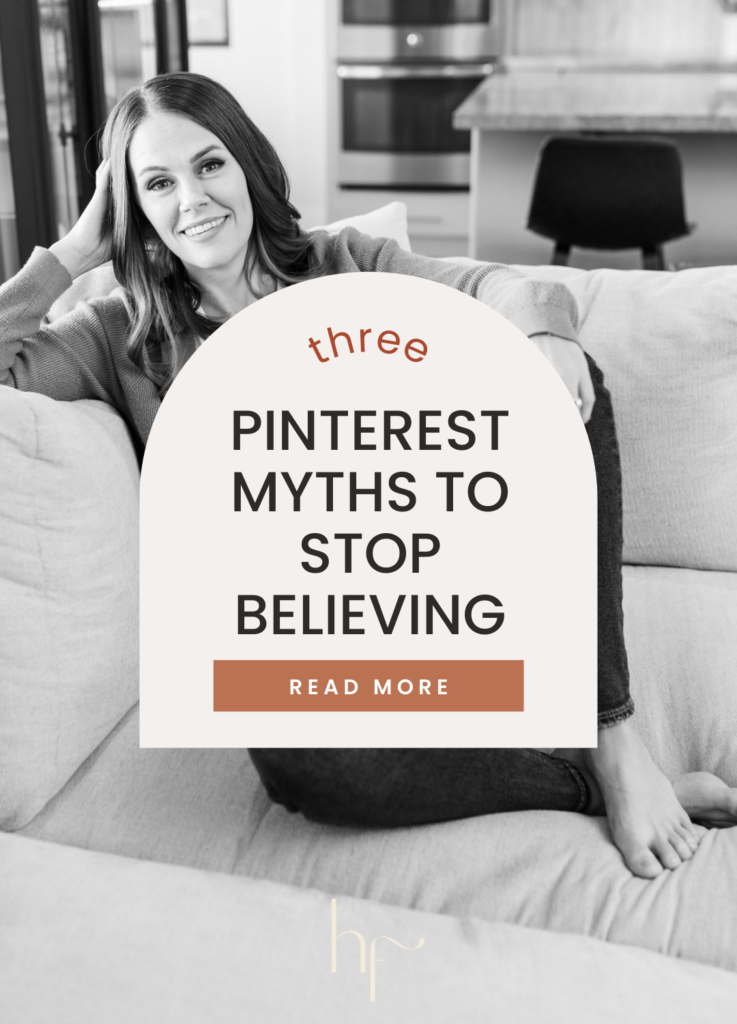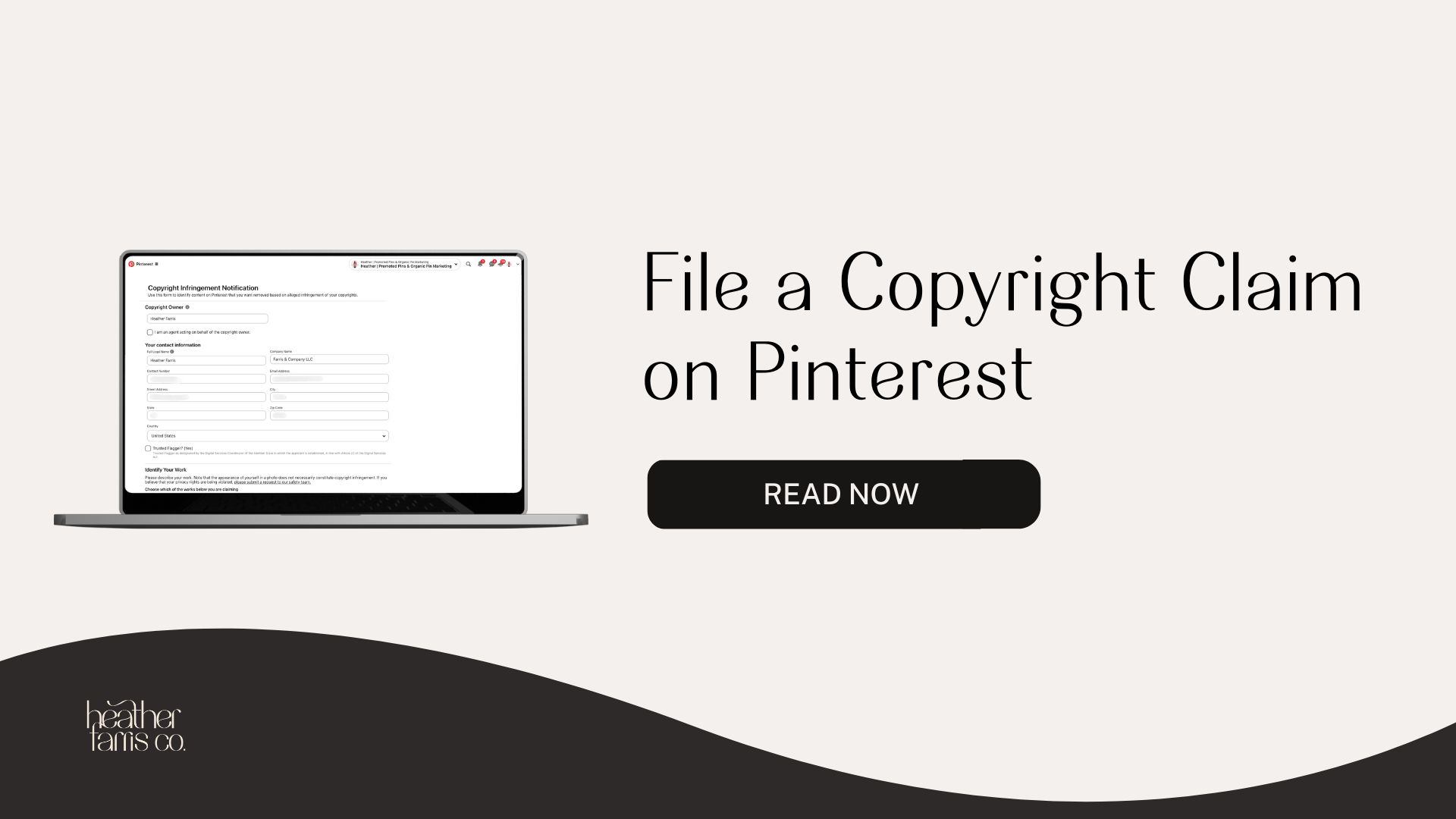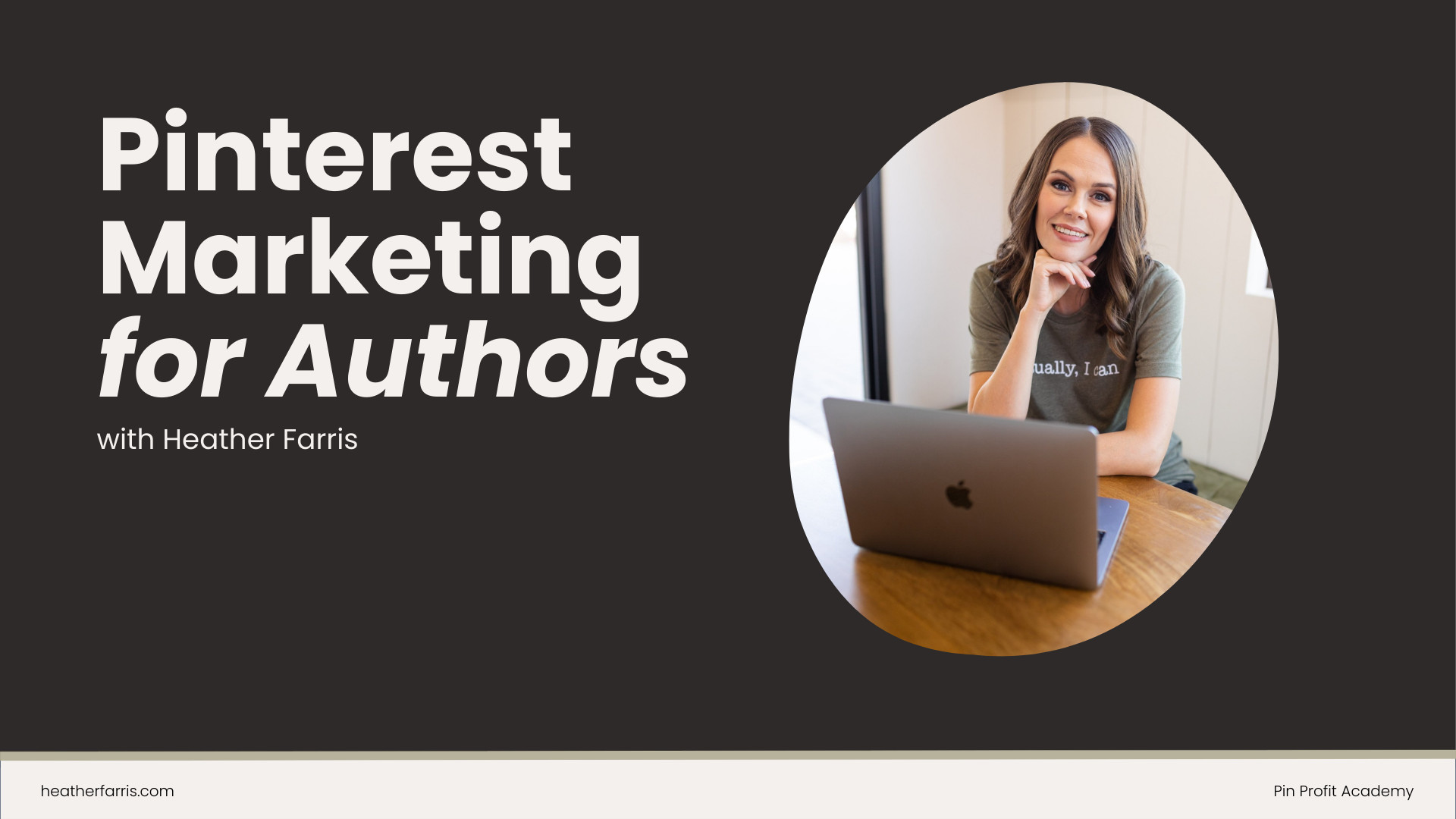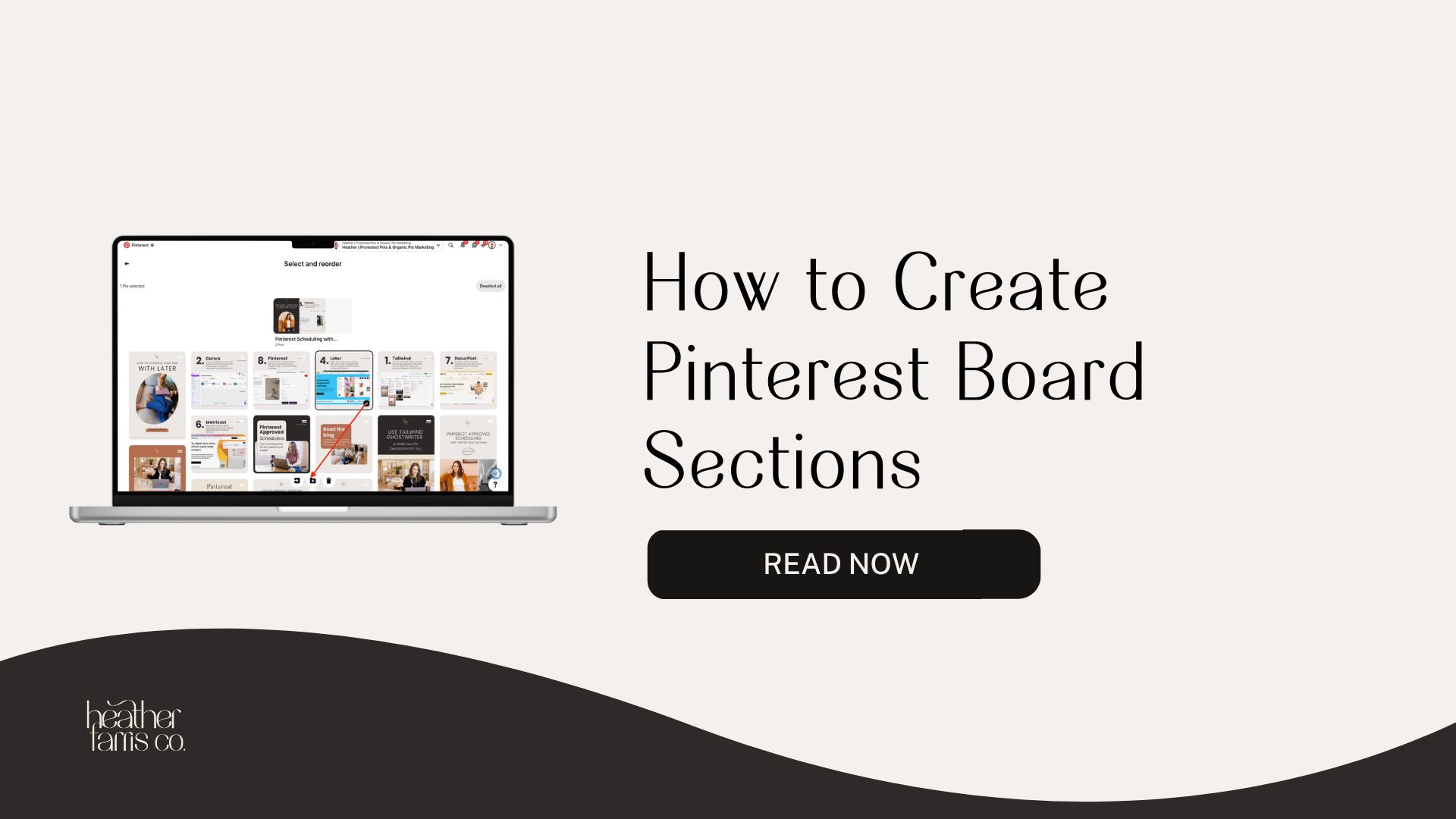Heather is a seasoned
Pinterest marketing expert & educator using the platform since you could reach the bottom of the feed - 2010.
About Heather Farris >
3 Pinterest Myths That You Should Stop Believing
February 27, 2023
If you are ignoring organic marketing strategy in your business because you’re listening to these Pinterest myths, you’re leaving out the ability to build content consistently on platforms where people can find you, consume your content without you having to be there and then become part of the consistent funnel in your business.
Don’t listen to these Pinterest myths when creating your marketing strategy
Organic marketing, in general, is not dead. And organic marketing on Pinterest is also not dead, one of many Pinterest myths. Here are three myths about organically marketing your business on Pinterest or any other platform you need to understand going into the next year.
My name is Heather Farris, and I run a Pinterest YouTube channel, a paid membership program, and a done-for-you Pinterest Agency. I have been around these Pinterest streets for almost six and a half years. I am here to tell you that organic Pinterest marketing is alive and well!
Pinterest Myths #1. Organic Pinterest traffic is dead
Probably the biggest key of all Pinterest myths. People are seeing many more ads on this platform now and thinking that you have to advertise to get the traffic you want. In fact, the majority of our clients are all organic and do so successfully on Pinterest. We are parking content on Pinterest.
Pinterest is a platform where you can consistently show up in someone’s feed, and all they have to do is interact with your content one or two times. They don’t even have to follow you to be presented with your content. They can also be presented with your content through search and related fields.
So organic Pinterest marketing is not dead, and I want to make that clear from the get-go.
RELATED: The Ultimate Pinterest Traffic Strategy for Bloggers & E-Commerce Shops
How keywords play a role
Now, if you are utilizing keywords on Pinterest that are more competitive, then you are going to have a harder time showing up. More competitive keywords are generally shorter or very, very popular topics.
So if you’re in one of the big niches like home decor, fashion, and food, then you’re likely having a harder time showing up organically if you use more broad or higher competition keywords.
I utilize longer tail keywords on all of the websites I’ve ever managed for my brand, for my own companies, and for clients. I’ve proven myself over and over that I can show up for those keywords on Pinterest. I do this by not only by using them consistently, but also by utilizing strategies other people aren’t doing, like polarizing titles and text overlays.
So here are some examples I want to show you about organic for my brand, my travel blog.
RELATED: How to Use Keywords to Optimize Your Pins on Pinterest
Example 1: Tips on buying an RV
For this particular search, I show up around six times throughout each scroll. So throughout the scroll on the screen, I have about six different pins showing up in this feed. Not many people are talking about tips on buying an RV the way I am. The way I present my information makes people want to click on it, which helps to drive me to the top of that search.
Example 2: RV valances
This is the one that I’m most proud of because I get around 60,000 page views a year from just this one blog post and Pinterest. I am all over this feed. As you can see, I have squatty little pins from the blog post, images of my RV with no text on it, no context, and tall Pinterest images saying how to update your RV window valances and stop making them look ugly. I’m using titles and text overlays that make those pins clickable.
Example 3: How to flat tow behind an RV
The final example I want to show you is a video my husband and I filmed for our travel YouTube channel on how to flat tow a Jeep behind an RV. Our two videos cumulatively have around 200,000 views on them, and I consistently rank on page one or towards the top of page 1 for Google for the keyword that people are searching for.
I’m also constantly ranking within those Pinterest search results, not only for my Pinterest pins but also for the YouTube video I shared to Pinterest that is optimized for search based on the title. Now example number one leads us nicely into the second myth.
RELATED: Stupid Simple SEO Review: How to Learn SEO Step by Step
Pinterest Myths #2. You have to be in one of the big niches to gain traction
This statement is vehemently false, probably one of the Pinterest myths that bugs me the most. You will have a better chance of success on Pinterest if you’re not in one of the bigger niches because there’s less competition.
For example, on my Pinterest marketing HeatherFarris.com website, I talk about a myriad of different things. My topics have multiple pillars, and one of those pillars is software. I love teaching and sharing how I use software.
I like to do software in a super simple way, but I also get all the value from the tool. One thing I share a lot about using ClickUp for Pinterest use, and I talk a lot about ClickUp for client management. Those pins rank well on Pinterest. Software as a service is not a super popular vertical on Pinterest, but I still tend to do well in that space.
Another example of content not in a big niche is my Pinterest ads content. I wrote two guest blog posts for Jessica Stansberry that ranked at the top of the Pinterest Ads search, which drives traffic not only to her website but also to my website because I have a link on her site. This is working really well for me, even though the top two pins in the Pinterest ads content are from Jessica. They’re technically mine, and my name is on the byline of those articles. So then people come out and find me from those.
I have other pins that are sprinkled throughout Pinterest as content as well. And again, this is not food, fashion, entertainment, home decor, or anything like that. These are marketing tips, and I still get good traction.
So you do not need to be in one of the big niches to succeed.
PRO TIP – Find those long tail keywords that relate to your content that people are searching for on Pinterest and hammer the crap out of them.
Use those keywords for new pins consistently. The more you use those keywords, the more pins you create for that keyword, and the more engagement you build on those pins within that keyword, the better those pins will rank in search.
This is true for the examples I’ve laid out, not only in the RV example and myth number one, the Pinterest ads and ClickUp examples.
RELATED: 6 Places to Use Keywords to Optimize Your Pinterest Profile
Pinterest Myths #3. You need a scheduler to succeed
Wrong! One of the most ridiculous Pinterest myths. You don’t need a scheduler to succeed on Pinterest. A scheduler will not help you to hack your way to the top of the Pinterest search, nor will it help you to get in front of more people. A scheduler is only there for one reason and one reason only: to help you stay committed to your workflow and show up consistently without having to be online to pay.
When clients, students, or friends of mine come to me and ask about a scheduler, the first thing I tell them is to use the native scheduler. Use the native scheduler; you can schedule up to 14 days in advance. You do not need to pay for something until you are ready to pay for something.
For example, I use Planoly, which is $9 a month for me. I am on an old grandfathered pricing tier. However, I utilize it for two scheduling platforms: Pinterest and Instagram. This allows me to stay consistent in my workflow without having to go to every platform to schedule the content. So it combines two platforms into one tool. That works for me, and it’s worth my investment. You do not need a scheduling tool to succeed on Pinterest.
RELATED: Pinterest Scheduling with Canva and Planoly (My Pinterest System Workflow)
Final thoughts on Pinterest myths you should stop believing
After setting the record straight on these Pinterest myths, if you are looking to get started on Pinterest or begin creating a strategic marketing strategy on this platform in the coming months into next year, I encourage you to hop on my email list. I’m dropping a Black Friday-only offer. So if you’re watching this after Black Friday, get on my email list. Chances are I’m going to mention it, or it’s going to be in my Academy.
All of my academy members will get this offer free because that’s the way that I like to vibe. So if you don’t want to be part of a monthly membership that’s recurring every single month, you don’t want to have to keep up with that commitment, get on my email list. I’m dropping a succinct, detailed Pinterest System for Black Friday, and I want you to get your hands on it before anyone else.

At the very least, go down below, and grab my Pinterest Strategy Guide. That’s how you can get on my email list, and you’ll be the first to know when that offer drops in about a month and a half.
That’s it for now. If you want more Pinterest marketing strategy tips, head to my Pinterest Marketing Playlist and watch those videos. I will see you next week.
Pin it for later


Heather Farris went to school for accounting and worked for years in banking and finance. After finding all of that entirely too boring she started her first blog in her basement in August of 2016. She has started 3 blogs in the marketing, motherhood and travel niches and used Pinterest to grow them all. She quickly became the go-to Pinterest strategist in her peer circles and has been implementing strategies, driving traffic and sales through organic and paid tactics for her clients. On this blog and her YouTube channel, as a renowned Pinterest marketing expert, she educates the public about clear and transparent marketing strategies to help them to grow on Pinterest and in other places online.





